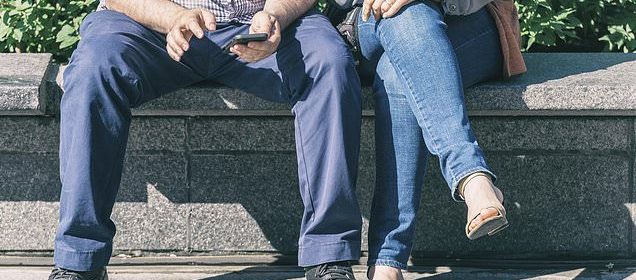Women should sit like men to prevent hip and knee pain, surgeon says

Ladies, manspread! Sitting like a man is the best way to prevent knee and hip pain, top orthopedic surgeon says
- Women are more susceptible to knee and hip pain due to their wider pelvises
- But a common cause of knee and hip pain is sitting cross-legged or leaning to one side while standing
- Dr Barbara Bergin, an orthopedic surgeon in Texas, says women should sit and stand like men to avoid pain
Women should ‘manspread’ – instead of sitting cross-legged – to prevent developing knee and hip pain, a top orthopedic surgeon says.
Barbara Bergin MD sees thousands of patients a year who are struggling with pain under their knee-caps and in their hips – and 90 percent of them are women.
Dr Bergin, who practices in Austin, Texas, believes the driving factor is that women have been trained that it is ‘ladylike’ to sit with their knees together, which twists the femur, putting strain on the joints and the supporting muscles.
Men, meanwhile, tend to sit with their legs spread and their feet firmly on the ground (so-called ‘manspreading’), keeping their body aligned and stable, and stand firmly on both feet, rather than leaning to one side.
In fact, Dr Bergin says, male standing and sitting positions are even better for women than men, because their wider pelvises naturally rotate the femur in.
Dr Barbara Bergin, an orthopedic surgeon who practices in Austin, Texas, advises women to embrace classically male sitting positions to prevent the onset of knee and hip pain
‘I’m not suggesting you S.L.A.M. [sit like a man] constantly,’ Dr Bergin said.
‘I still think it’s best to keep legs shut when wearing a skirt and in the presence of men. It’s just proper and ladylike. But 90 percent of the time, sitting like a man is fine, and certainly better for your health.’
Leg-crossing is relatively recent behavior for women.
Women have been taught to sit with their knees together since at least the 1300s as a sign of chastity, etiquette expert Myka Meier told the Washington Post.
But with floor-length skirts it wasn’t vital. And, in fact, some Victorian-era etiquette guides said it was unbecoming for women to cross their legs because it could cause them to slouch or sit at a slant; better to have both feet planted on the ground. Indeed, portraits show Queen Victoria favored a man-spread.
That all changed as the 1900s rolled on, and skirt lengths ascended to mid-calf, then past the knee. Then, it was considered ladylike – even essential – for women to cross or knock their knees.
Whether your feet are on the ground or not, keeping the knees together puts undue stress on two key tendons that are responsible for chronic pain: the iliotibial (IT) band that runs along the outside of the leg, and the greater trochanter which runs around your hips.
Men typically sit with their feet flat on the ground, allowing their tendons to relax, while women have long been trained to sit cross-legged, causing stiffening
IT band syndrome, a painful knee condition, occurs when the ligament tightens so much that it rubs the bones. It can be caused by running – a common injury for marathon runners – but it is most strained in a sitting position, with the bent knee pulling the tendon. Crossing or knocking the knees exacerbates it.
The best antidote is to avoid sitting. But if you need to sit, do so with your feet flat on the ground, your legs slightly apart (Dr Bergin, author of the book Sit Like A Man, recommends thinking of 11 and 1 on a clock), and your knees level with or below your hips, to allow the IT band to stretch.
Greater tronchateric pain syndrome (or, lateral hip pain) causes pain to shoot down the sides of the hips and the thighs, even as far as the knees, and can be debilitating.
The main causes are: sitting for long periods, leaning on one leg rather than the other, and crossing the knees. It is particularly common among women over 40, who are already prone to hip strain due to their wider pelvises, more commonly sit with crossed legs, and lean when standing.
Dr Bergin advises: ‘Allow your thighs to gently rotate outward. Do not place your feet outside of your knees. That causes the thighs to rotate inward and the knees to angle inward as well.’
Source: Read Full Article

